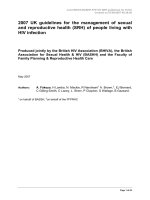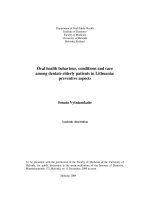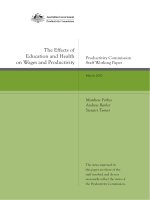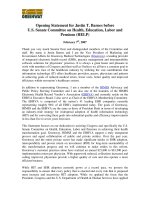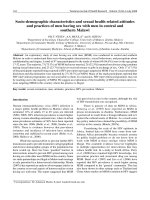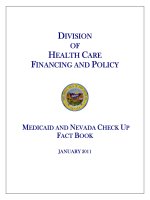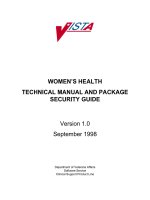28 health kidney interpretation and interventions
Bạn đang xem bản rút gọn của tài liệu. Xem và tải ngay bản đầy đủ của tài liệu tại đây (763.19 KB, 16 trang )
UNIVERSITY
Health
Kidney Interpretation and
Intervention
Lesson Overview
Functions of the Kidney
How the Kidney Works
AAS and GH Impact on Kidney
Dose Type and Dosage of AAS Matter?
Signs of Kidney Dysfunction- Lab work
Kidney Lab interpretation
Kidney Health Intervention Strategies
Functions of the Kidney
Prime function is balance of fluids, electrolytes, and organic solutes via
continuous filtration of blood.
Filters 180L of blood per day into ultrafiltrate which is further turned into
the 1.5L of urine excreted per day.
Waste removal of uric acid, ammonia, and creatinine
Maintains body pH via excretion of H+ ions and reabsorption of
bicarbonate
Regulation of Blood Pressure via secretion of Renin > Angiotensin
(vasoconstriction) > Aldosterone (sodium and water reabsorption)
Secretes Erythropoietin and Calcitriol (1,25[OH]2 Vitamin D3 (Ca/P
homeostasis)
Regulation of blood volume via Vasopressin from the hypothalamus
causing increased water reabsorption
How the Kidney Works
Kidney composed of 1million nephrons, one part damaged,
nephron is nonfunctional
Glomerulus produces the ultrafiltrate contains Podocytes with AR
and ER.
Tubules is site of electrolyte exchange and urine formation
A Primer into Lab Work
AAS and GH Impact on Renal
Function Case Studies
Hertlitz et al. 2010
focal segmental glomerulosclerosis
(FSGS) and proteinuria in a cohort of 10
bodybuilders
The clinical presentation included
proteinuria (mean 10.1 g/d; range 1.3 to
26.3 g/d) and renal insufficiency (mean
serum creatinine 3.0 mg/dl; range 1.3 to
7.8 mg/dl); three (30%) patients
presented with nephrotic syndrome
Renal biopsy revealed FSGS in nine
patients, four of whom also had
glomerulomegaly, and glomerulomegaly
alone in one patient
Among eight patients with mean followup of 2.2 yr, one progressed to ESRD
ARB main treatment modality
Average BMI 34.7kg/m2
AAS and GH Impact on Renal
Function Case Studies
El-Reshaid et al. 2018, Prospective Study of 22 male Bbers
Dosages of testosterone 250mg/day on average 100mg/day.
Greater exposure time presented with greater renal damage
Hypertensive changes were present in all patients
How do PEDs Effect the Kidney
Acute Kidney Injury (AKI): acute decrease in Glomerular filtration rate
(GFR)
GFR: amount of filtrate per unit in the nephrons, typically estimated
from serum creatinine.
Causes can be classified into 3 categories:
1. Prerenal: dehydration, hypercalcemia, vitamin D toxicity, liver
cholestasis (17aa oral AAS)
2. Intrinsic: Acute tubular Necrosis, interstitial nephritis,
Rhabdomyolysis
3. Post renal:, BPH. Urinary tract obstruction
How do PEDs Effect the Kidney
Chronic Kidney Disease (CKD) Gradual loss of kidney function.
1. Diabetes and Hypertension leading cause
2. Renal Blood Pressure regulation: AAS upregulation of RAAS
increase BP and sodium retention
3. Increased Endothelin = increased vasoconstriction
4. Oxidative Stress: increased ROS
5. Apoptosis and Inflammatory cytokines: Increased TNF alpha and
IL6, cell death of podocytes and glomerulosclerosis (renal scarring)
6. Kidney contains GH, IGF1 receptors along with AR, ER receptors,
GH can activate RAAS increasing BP
7. Estrogen is kidney protective
8. Increase in lean body mass and high protein intake can result in
glomerular hyperfiltration
9. TRT therapy renal protective
PED Dose Effect
Animal model:
“Effect of Nandrolone Decanoate, Boldenone Undecylenate on Renal Status
of Rabbits”
Nandrolone Decanoate (ND) 4.5mg/kg body wt
Boldenone Undecylenate (BOL) 10mg/kg body wt and combination of both
(ND+BOL) 14.5 mg/kg body wt on renal system of male rabbits
Nandrolone and boldenone alone lead to similar creatinine levels, while the
combination lead to the greatest increase in creatinine
Human model:
“Evaluation of anabolic steroid induced renal damage with sonography in
bodybuilders”
Group 1 (n=8, intramuscular 500mg testosterone enanthate, intramuscular 400
mg nandrolone decanoate and oral 40 mg methandrostenolone for 12 weeks),
Group 2 (n=7, intramuscular 500 mg testosterone enanthate, intramuscular
300 mg nandrolone decanoate and intramuscular 300 mg boldenone
undecylenate for 16 weeks)
Group 3 (n=7, no steroid intake)
Plasma levels of BUN and creatinine were increased in group 2 (P ˂ 0.001)
compared the other groups (Table 1). Right and left kidney grade, the thickness
of renal parenchyma and renal volume were significantly increased in group 2
Lab Tests and Abnormalities
Kidney Function Test:
Lab test
Range
interpretation
Creatinine
0.8-1.5mg/dL
Byproduct of creatine, higher with increased lean body
mass. Represent renal filtration.
BUN
6-20mg/dL
Reflection of liver and kidney function, high in
dehydration and high protein intakes (HYDRATE PRIOR
TO LAB TESTING)
BUN/Creatinine
6-28 ratio
Determine cause of renal issue. >20 prerenal
dehydration. <10 renal damage, 10-20 post renal
obstruction
Cystatin C
0.6 to 1mg/L
Elevated in renal failure, used to calculate eGFR but not
impacted by lean body mass
eGFR
>60-90ml/min/1.732
Calculated by creatinine, age and gender
Albumin serum
3.5-5.2g/dL
Low in kidney disease, increased protein loss in urine
Calcium, serum
8.5-10.5mg/dL
High in vitamin D toxicity, nephrocalcification
Phosphorus, serum
2.5-4.5mg/dl
Increased in kidney disease
Sodium, serum
133-146meq/L
Fluid balance kidney regulated. Hypo or
hyperhydration, tightly regulated
Potassium, serum
3.5-5.4meq/L
Inversely related to sodium, increases cause
aldosterone release, high in kidney failure
25 OH D
40-60ng/ml
High or low dependent on vitamin D intake
Glomerular Filtration Rate
We rely heavily on this measure for prediction of renal function
Normal 90-120ml/min/1.732
GFR in lab work is estimated (eGFR) over directly measured
eGFR is based on serum, creatinine levels
In athletes eGFR may be underestimated using creatinine due to
increased muscle mass and creatine supplementation.
Cystatin-C based eGFR formula may be a more accurate measure of
kidney function
Serum creatinine, can also remain wnl, and not represent true
decrease in renal functional decline.
Kidney Health Intervention
Dyslipidemia, Hypertension and Diabetes are independent risk factors for CKD, follow
all previous recommendations around the topics a few repeats will occur. Blood
pressure and blood sugar control essential.
Dietary Interventions
HYDRATION
Protein intake 1-1.5g/lb is acceptable and safe
Increase fruit and vegetable intake
Limit excessive salt intake if responsive
Increase nitrate rich foods (beets, spinach, arugula)
Supplement Strategies
*review hypertension supps
(omega 3, vitamin D +K2, cocoa, garlic, CoQ10, beet root)
Monitor excessive Vitamin D and calcium intakes
Curcumin 1500mg (intestinal barrier strengthening, decreased TNF alpha and IL-6,
decrease ROS)
Grape Seed Extract 1-2g/day (anti-inflammatory and anti-oxidant)
Arjuna 500mg (reduce oxidation)
Astragulus Membranaceus 4-6g/day (increase ANP, decrease cytokines)
Kidney Health Intervention
PED Interventions
Limit 17aa orals as they increase risk of AKI cholestasis
Renal toxicity is dose responsive, limit doses and duration of use
Estrogen is renal protective, don’t over suppress Estradiol
Potential for Boldenone to be more renal toxic, (not human use
approved)
Drug Intervention
Blood pressure medications
Telmisartan BP med of choice (Angiotensin II receptor blocker)
Metabolic effects: Increase Peroxisome Proliferator activated receptor
gamma and delta (PPAR)= increased insulin sensitivity, reduces
dyslipidemia, increased HDL, decreased visceral fat, increased fatty
acid oxidation
Vascular effects: prevention of vascular smooth muscle cell
proliferation greater than other ARBs.
Renal effects: Lowers BP via Renin angiotensin aldosterone system
(RAAS), prevents fibrosis, decrease TGF-beta, decreased oxidative
stress.
References
Faria, João & Ahmed, Sabbir & Gerritsen, Karin & Mihaila, Silvia & Masereeuw, Rosalinde.
(2019). Kidney-based in vitro models for drug-induced toxicity testing. Archives of
Toxicology. 93. 10.1007/s00204-019-02598-0.
Mahan, KL. Krause’s Food and Nutrition Care Process 13th edition. Elsevier: USA, 2012.
Herlitz LC, Markowitz GS, Farris AB, et al. Development of focal segmental
glomerulosclerosis after anabolic steroid abuse. J Am Soc Nephrol. 2010;21(1):163-172.
doi:10.1681/ASN.2009040450
El-Reshaid W, El-Reshaid K, Al-Bader S, Ramadan A, Madda JP. Complementary bodybuilding:
A potential risk for permanent kidney disease. Saudi J Kidney Dis Transpl. 2018 MarApr;29(2):326-331. doi: 10.4103/1319-2442.229269. PMID: 29657200.
Davani-Davari D, Karimzadeh I, Khalili H. The potential effects of anabolic-androgenic
steroids and growth hormone as commonly used sport supplements on the kidney: a
systematic review. BMC Nephrol. 2019 May 31;20(1):198. doi: 10.1186/s12882-019-1384-0.
PMID: 31151420; PMCID: PMC6545019.
Shabir N et al. Effect of Nandrolone Decanoate, Boldenone Undecylenate on Renal Status of
Rabbits (Oryctolagus cuniculus. Global Veterinaria 14 (3): 432-438, 2015
DOI: 10.5829/idosi.gv.2015.14.03.92201
Kantarci UH, Punduk Z, Senarslan O, Dirik A. Evaluation of anabolic steroid induced renal
damage with sonography in bodybuilders. J Sports Med Phys Fitness. 2018 Nov;58(11):16811687. doi: 10.23736/S0022-4707.17.06763-9. Epub 2017 Nov 17. PMID: 29148625.
References
Banfi G, Del Fabbro M, Lippi G. Relation between serum creatinine and body mass index in elite
athletes of different sport disciplines. Br J Sports Med. 2006 Aug;40(8):675-8; discussion 678. doi:
10.1136/bjsm.2006.026658. Epub 2006 May 24. PMID: 16723402; PMCID: PMC2579448.
Beetham KS, Howden EJ, Isbel NM, Coombes JS. Agreement between cystatin-C and creatinine based
eGFR estimates after a 12-month exercise intervention in patients with chronic kidney disease. BMC
Nephrol. 2018;19(1):366. Published 2018 Dec 18. doi:10.1186/s12882-018-1146-4
Ghosh SS, Gehr TW, Ghosh S. Curcumin and chronic kidney disease (CKD): major mode of action
through stimulating endogenous intestinal alkaline phosphatase. Molecules. 2014;19(12):2013920156. Published 2014 Dec 2. doi:10.3390/molecules191220139
Turki K, Charradi K, Boukhalfa H, Belhaj M, Limam F, Aouani E. Grape seed powder improves renal
failure of chronic kidney disease patients. EXCLI J. 2016 Jun 27;15:424-433. doi: 10.17179/excli2016363. PMID: 27822171; PMCID: PMC5083963.
Li M, Wang W, Xue J, Gu Y, Lin S. Meta-analysis of the clinical value of Astragalus membranaceus in
diabetic nephropathy. J Ethnopharmacol. 2011 Jan 27;133(2):412-9. doi: 10.1016/j.jep.2010.10.012.
Epub 2010 Oct 13. PMID: 20951192.
Ladino M, Hernandez Schulman I. Renovascular and renoprotective properties of telmisartan: clinical
utility. Int J Nephrol Renovasc Dis. 2010;3:33-38. doi:10.2147/ijnrd.s7033
Chujo D, Yagi K, Asano A, Muramoto H, Sakai S, Ohnishi A, Shintaku-Kubota M, Mabuchi H, Yamagishi
M, Kobayashi J. Telmisartan treatment decreases visceral fat accumulation and improves serum
levels of adiponectin and vascular inflammation markers in Japanese hypertensive patients.
Hypertens Res. 2007 Dec;30(12):1205-10. doi: 10.1291/hypres.30.1205. PMID: 18344626.
